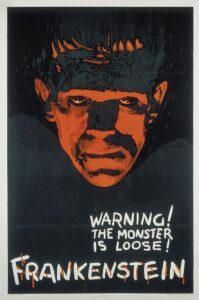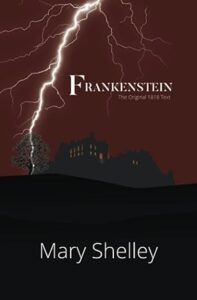Sherrill Joseph's Blog, page 2
October 29, 2024
Third’s the Charm
Dear Kids and All Readers,

Victoria Price Sharing About her Father, Horror Actor Vincent Price
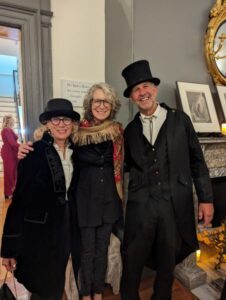 I grew up enjoying the inimitable actor Vincent Price being sinister in such horror film classics as House of Wax (1953), House on Haunted Hill (1959), The Tingler (1959), House of Usher (1960), and The Pit and the Pendulum (1961) to name a few. Price fans might also remember his dramatic performances in the movies Laura (1944), Dragonwyck (1946), The Whales of August (1987), and Edward Scissorhands (1990). And I can’t omit his rap in Michael Jackson’s song and video Thriller (1983). Mr. Price’s velvety voice and spooky laugh are indelible. You can watch it HERE on YouTube. It’s approximately 14 minutes long.
I grew up enjoying the inimitable actor Vincent Price being sinister in such horror film classics as House of Wax (1953), House on Haunted Hill (1959), The Tingler (1959), House of Usher (1960), and The Pit and the Pendulum (1961) to name a few. Price fans might also remember his dramatic performances in the movies Laura (1944), Dragonwyck (1946), The Whales of August (1987), and Edward Scissorhands (1990). And I can’t omit his rap in Michael Jackson’s song and video Thriller (1983). Mr. Price’s velvety voice and spooky laugh are indelible. You can watch it HERE on YouTube. It’s approximately 14 minutes long.
What a thrill for me when In the late 1980s, I had the pleasure of attending a special event in my hometown called, “An Evening with Vincent Price.” The audience was invited to ask questions at the end of his presentation. I had a question burning inside me for decades. Now’s my chance! . . . But alas, I was not called on. Strike one.
Fast forward to 2021. I took a Zoom writing class sponsored by Poe Baltimore and taught by Vincent Price’s daughter, Victoria. At the end of class, I told her I had a burning question about her father, but I preferred to ask it privately. She suggested I contact her via Facebook, which I did. I waited . . . and waited . . . but no reply! Strike two.
Then, a few weeks ago on October 5, my Book 5, Jacaranda Street: Gravestone Image, won an Edgar Allan Poe Saturday “Visiter” Award in the “Works Inspired by Poe” category. I was thrilled to be present with my daughter at PoeFest International in Baltimore, Maryland, to accept a medal and beautifully framed certificate!
That evening after the awards ceremony, my daughter, a fellow award nominee and author Steve Boilard (A Dying Wish), and I were exploring the “Poe Death Exhibit” in the Carroll Mansion when who should come into the parlor but Victoria Price! Many of her father’s horror movies were adapted from Poe poems or stories, so Ms.Price is frequently a guest of honor at PoeFest. (In the photo, Victoria Price is flanked by Steve Boilard and me.) I thanked her because . . .
At a movie reception the evening before, Ms. Price finally answered my decades-old burning question: “What special tricks or treats did Vincent Price like to pull on Halloween?” Her face lit up as she said her father used to take her Trick-or-Treating in their Beverly Hills neighborhood (the ultimate chaperone!). Instead of accompanying her to the door, he would hide in the bushes at each house, wait for the next group of candy scavengers, jump out, and scare the daylights out of them! The perfect answer I hoped for. Can you imagine? Lucky kids! Isn’t that the pinnacle of surreal Halloween magic? And for me, no Strike Three, but Third’s the Charm!
So, get a clue, Readers. Don’t give up on those burning questions. Look for opportunities to get them answered, even if it takes decades. At long last, it was for me a thriller. Happy Halloween!
September 12, 2024
Do You Know All Your ABCs?
Dear Readers,
Most people familiar with the Modern English alphabet would likely say that it contains twenty-six letters, beginning with A and ending with Z. And they would be correct.
But did you know that until the early 1800s, there was a twenty-seventh letter in that alphabet?
The “letter” followed Z. Can you guess what it was?
AND.
What? Wait a minute! “And” is a word, not a letter.
Are you sure?
Some Fundamental Alphabet History
According to historian Jane Sancinito and letterform scholar Johanna Drucker, around 3200 BCE, the Egyptians created hieroglyphs, images representing words, for sacred script. Over time, those were simplified to a cursive script and an even simpler hieratic script for faster writing and administrative use. Traders and travelers took that consonant script home to Phoenicia (Syria, Lebanon, and Israel) and surrounding towns and villages.
The Phoenician alphabet was created between 1700 and 1400 BCE when cuneiform writing and hieroglyphic writing were blended. The Phoenicians also established its alphabetic order. From that parent Phoenician alphabet descended all western alphabets including the Aramaic and Greek alphabets in the 10th century BCE, and the Hebrew alphabet in the 9th century BCE.
The Greek alphabet gave rise to the Cyrillic alphabet in the 9th century BCE. By 750 BCE, the Greeks added vowels to their Phoenician-based alphabet, creating what is regarded as the first “true” alphabet from which came the Latin alphabet in the 6th century BCE.
Old English was first written down using the Latin alphabet during the 7th century CE. Some letters came and went. The letter “W” was added to the Latin alphabet during the Middle Ages and the letters “J” and “U” during the Renaissance.
By the 16th century CE, the Modern English alphabet of twenty-seven letters was mostly stabilized with letters having an uppercase and lowercase form.
Back to AND
The Latin word for “and” is spelled et. Over time, ancient Romans blended the two letters to form a ligature, a printed or written character or symbol where two or more letters are joined. Imagine an uppercase “E” smashed alongside a lowercase “t.” Soon, that blended Et became the symbol “&.” Notice the uppercase cursive letter “E” merged with the lowercase cursive letter “t”? According to Keith Houston, author of Shady Characters: The Secret Life of Punctuation, Symbols & Other Typographical Marks, the & symbol was first found in some “anonymous graffiti” in the famous ruins of Pompeii, so it obviously predates the eruption of Mount Vesuvius in 79 CE.
More Relevant History
Beginning in the late Middle Ages, single English letters that also served as words (like “I” and “A”) were distinguished as letters with the help of the Latin phrase per se: “I” per se, I—meaning “I” by itself, I (the letter, not the word).
As to our extinct twenty-seventh letter within the English alphabet, let’s use the Latin ligature Et’s symbol “&” for “and,” then add the Latin per se phrase: “&” by itself, and. “&” joined the English alphabet as a letter possibly in the 17th century due to its popularity, mostly in business.
Onward to the Classroom
When students were reciting the English alphabet, it was confusing to say “X, Y, Z, and.” So, children would say “and” per se, and. That meant “and” by itself, and—the first “and” being the symbol &. So that’s how and why the English alphabet ended with X, Y, Z, &.
Now, for some fun! Say “and per se, and” quickly. Do you hear it? Somewhere in time, “and per se, and” was corrupted into the name of the symbol &—becoming ampersand.
The song “A Was an Apple Pie” was used to teach children the alphabet in the 1800s and at least as far back as the reign of England’s King Charles II in the 1660s. It ended with the lyrics:
“X, Y, Z and ampersand
All wished for a piece (of pie) in hand.”
But around 1835—dates differ—some thought it strange that & would still be called a letter since it resulted from an ancient ligature and represented a word, not a classic phoneme. So, the twenty-seventh “letter” & was dropped from the English alphabet and relegated to the punctuation pile. But it was not forgotten. It pervades worldwide businesses like Barnes & Noble, Dolce & Gabbana, Tiffany & Co., and Lindt & Sprüngli for concision and brand recall.
So, get a clue, Readers! The evolution of written language can be fascinating. I hope you, too, will discover something remarkable in the history of communication.
(Photo Credits: Photos 1 and 2 from pexels.com; Photo 3 from pixabay.com)

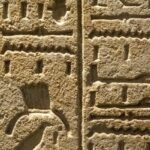
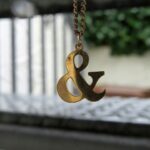
August 27, 2024
School Daze
Hello, Kids, Educators, and Families–
Are you happy that school’s back in session once again?
The answer probably depends on who you are!
Kids might be sad that summer is over but thrilled to be back with their friends and meeting their new teachers for a fresh crack at learning in the next higher grade.
As a long-time, now retired teacher, I felt like those kids, reluctant to give up the carefree days of summer but glad to return to children and adults who made me feel happy, rewarded, and grateful. It was the start of another year practicing and honing my craft for which I spent years in college (plus in all grades!) and on the job preparing.
Parents and grandparents are likely breathing a sigh of relief! Though perhaps looming are the challenges that their children’s homework, classrooms, classmates, and stringent routines can bring.
To digress, every year around this time, I can’t help but reminisce about getting ready for school to begin when I was a child. Here in San Diego, California, back in the 1960s, public school opened in mid-September. So, in mid-August, my mother would trot my fraternal twin sister and me uptown to the neighborhood J. C. Penney’s store. It was time to load up on five brand new, starched plaid cotton dresses apiece–one for each day, Monday through Friday. Girls weren’t allowed to wear pants or shorts to school until the rules changed in what was then called Junior High (Grades 7 – 9).
My mother insisted that her twin daughters dress alike. (Ugh!) This was often problematic from a practical standpoint: Not only did my sister and I have to find dress styles we both liked, but we also had to find them in our respective sizes. Occasionally, Mom would fudge on her twin dress code and let us get the same style, but in different colors. (Whoohoo! Individuality.) After hours selecting and trying on dresses, we headed to the checkout counter, smiles on our faces, and arms loaded with our new clothes. My mom would take advantage of the store’s “Layaway Plan,” paying half of the bill that day with the balance due when we picked up the dresses one month later on the Saturday before the big day. Oh, the anticipation!
The night before school started, butterflies flitted in my stomach. Would I get the teacher I wanted? Would she or he be nice? Would I be smart enough to be in a new grade? What would we have to do on the first day?
And wouldn’t you know it? Those were also the reactions and similar questions I had every year as a teacher! Except as the adult, I was the one calling the shots. My indelible nervousness as a child informed how I approached my new students yearly–with empathy, caring, concern, and lots of smiles. The kids were always surprised and relieved to learn that we (human) teachers had butterflies on the first day, too!
So, get a clue, all Readers. Do you get nervous in the lead up to the first day of school? How do you prepare for the big day? And how do you cope as you head to school and enter the new classroom? Whatever you do, kids, educators, and families, have a wonderful new school year! And kids, be sure to read every day. Reading makes you smarter.




(Photos from pexels.com)
July 17, 2024
“Paws” for Pets
Hello, Kids and All Readers,
I have some family news to share! I became a grandmother for the fourth time on July 12. I have two grandchildren, a granddog, and now the newest addition–a grandcat!
Agnes, as she is named, is an all-black cat with amber-orange eyes. Perfect for Halloween, right?
My daughter rescued Agnes from a busy street when the cat was almost hit by a car. The neighbors had captured her kittens but couldn’t find her, and no one could identify her owner. Since my daughter held the erstwhile elusive cat in her arms, she bundled tiny, six-pound, scared Agnes into the car, took her to the vet for a good checkup, then home! But not before stopping at a pet store to load up on all the things (and more) that one could need for the care, love, and feeding of a cat.
Agnes wasted no time settling in to her new home. She is now enjoying lots of square meals a day, fresh water, a soft bed, a self-cleaning litter box (you read that correctly), a bling collar, toys, much love, and safety. Who could want more?
And everyone loves Agnes including Dash the dog. I think he thinks she’s a toy, or at least a new playmate. He even rolls over for her and lets her drink out of his personal water bowl. What a gentleman! And all the House Humans are over the moon with her.
So, get a clue, Readers. Do you have pets? Do you like to read books where characters have pets? I know that kids tend to like stories with them, so each of my four Botanic Hill detectives have animals roaming around the house. After all, pets can take the edge off a tough day chasing down the bad guys. Rock on, Agnes!



June 20, 2024
Welcome, Summer Solstice!
Dear Kids, Teachers, and All Readers,
Happy Summer! The season when children and educators get giddy, and parents wonder what to do with the kids for three months.
However you plan to spend this summer, I hope it’s one of your best.
I get nostalgic this time of year as I reflect back on wonderful childhood summers.
My twin sister and I spent nearly every day with our cousin, who is two years older than us. She lived one block away, so by mid-morning, we met either at her house or ours, ready for another day of fun. On the way out the front door, my grandmother would say, “Just be back by dinnertime.” Those were the days when kids felt safe to explore without adults hovering or planning their time.
Off the three of us went, usually walking about a mile to Balboa Park, the jewel of our city. Back then, the San Diego Zoo, part of the park, was free for kids, so that’s where we often started. My cousin used to enjoy the Reptile House. Not I, but we would go with her, anyway, because she always made it fun. She shared interesting things about the snakes or whatever animals we encountered. We would stop and say hello to the elephants, giraffes, and lions, ending up at the Children’s Zoo–a zoo within the zoo–and watch the little white rodents in the Mouse House, a large loaf of bread where they ate their fill. Then, we’d go to the petting paddock and rub down the goats and donkeys and feed them carrot and celery sticks stuffed into ice cream cones (minus the ice cream). But watch out! The goats loved to nibble on clothing.
Sometimes if we had money from our allowances, we would buy hamburgers, French fries, and cokes at the zoo. While eating our lunch, we would listen to the park’s enormous bell tower chime all four quarters of the hour but keep an eye out for swooping seagulls. They were master food thieves, stealing goodies right out of our hands!
Once our cousin learned to drive, we would pile into her family’s car with our own homemade picnic lunches and head for the beach. Our favorite was La Jolla Shores. We took rafts and rode the waves into shore, built sandcastles surrounded by moats, which we filled with seaweed “dragons,” slathered ourselves with baby oil, and sunbathed for golden tans. (No one knew about skin cancer yet.) Often, we waded out into the ocean, waist high, and dove into huge waves before they crashed. We were fearless. Sharks? What sharks? On the way home, we always stopped at the drugstore for ice cream cones. Chocolate for me, always chocolate. My sister liked vanilla or strawberry while our cousin favored pistachio or rocky road.
Other days, we would stick closer to home and take our lunch and a blanket to “The Green,” a small park three blocks south of my house, for a picnic. I would pack either a peanut butter and grape jelly sandwich or a cheese sandwich, a small bag of Fritos, a brownie from the bakery truck, and plums or peaches, but mostly peaches. I remember eating way too many for a kid some days–maybe four!–because my mom would buy them by the lug. I still remember those comforting peach scents perfuming the back porch, smelling of summer.
On days when it was too hot, we would hang out at my cousin’s house. She would make us tuna sandwiches, full of chopped onions, and serve ice-cold lemonade. Afterwards. we would have popcorn while plunked down in front of her television set, hoping to catch an afternoon monster movie. We were seldom disappointed. But if we were, there was always Monopoly standing by!
So, get a clue, kids and all readers. I hope you get out and have a blast under the summer sun. May you create some fabulous memories to sustain yourselves in the years ahead. Eat lots of peaches, but not too many. And don’t forget to use sunscreen.



May 20, 2024
Happy Birthday, Flock!
Happy Fourth Birthday, Blackbird Writers!
Hello, Dear Readers! This is an invitation to join the celebration:
My fellow “four and twenty” Birds and I are celebrating four years flying together to “bring mystery and mayhem to the world,” one book at a time.
Our flock of supportive mystery writers took flight in May 2020, thanks to founder and thriller author, Tracey S. Phillips, who was concerned about writers’ isolation during the Pandemic.
I was welcomed into the group in October of that year and am one of three children’s authors though the only one writing Middle Grade mysteries (ages 9-12). Other genres include romance thrillers, police procedurals, cozy mysteries, international intrigue, crime thrillers, YA suspense, paranormal mysteries, and more.
Please check out each of us Birds and our books HERE, or go to https://blackbirdwriters.com. If you purchase a few of our books, we would be very grateful. Thanks for your support!
So, get a clue, Readers! Never be afraid to celebrate a birthday. It beats the alternative!
(Ad Credits: Colorful ad by Sherrill Joseph; black-and-white ad by Blackbird Writers)

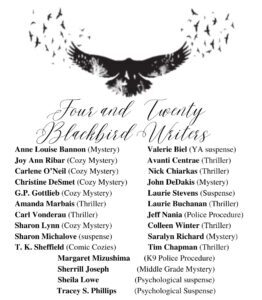
April 22, 2024
Filing on the Prison Bars
Dear Readers,
We’ve probably all seen movies or read stories where someone, somehow sneaked a large file into a jail cell to help a prisoner have at the metal bars to enable an escape.
I’ve been a “prisoner” in a kind of “jail” for a few years now–the jail of clutter! And the kind of “file” I’m talking about is my file cabinet, bursting at its metal seams with folders of stuff that go back to my childhood. I had more recent files stacked on a table next to the cabinet because I couldn’t get another piece of paper inside it with the proverbial shoehorn!
 I was inspired to start decluttering my file cabinet for two additional reasons: 1. Spring Cleaning; and 2. A free paper-shredding community event at a local school last Saturday. I started purging my files, one folder at a time, A to Z, about a month ago during my evening downtime. I got pretty good at zipping through a stack each night.
I was inspired to start decluttering my file cabinet for two additional reasons: 1. Spring Cleaning; and 2. A free paper-shredding community event at a local school last Saturday. I started purging my files, one folder at a time, A to Z, about a month ago during my evening downtime. I got pretty good at zipping through a stack each night.
But one folder that took an entire evening was “Favorite Articles.” It’s the folder where I threw (and continue to throw) special greeting cards, media clippings, letters, and other sentimental, Romantic-Era-type treasures saved over the decades. I pondered to read many of them, and I discovered that my curation has remained quite consistent over the years.
Mostly, I had squirreled away magazine pictures of curving staircases, a lifelong obsession. And my favorite kind of writing, namely, descriptive: atmospheric verses, especially from Halloween greeting cards; the poem “Ithaca,” Jacqueline Kennedy Onassis’s favorite, which was read at her funeral in 1994; a Parade Magazine article from 1982 entitled “Our Family Ghost,” written by the nephew of William Faulkner about their haunted family mansion in Oxford, Mississippi; a recent addition from the New York Times about Lord Byron; a list of my favorite childhood books; and essays I wrote about the gorgeous houses south of me that, as a child, I loved to pretend were my castles (and still do!).
Two items that brought me to tears were a musical program guide from Van Cliburn’s 1994 visit to San Diego. My dad played classical piano, and Van Cliburn was his hero. So, I saved my money and surprised him with tickets to the performance, as well as the pre-concert dinner, and after-concert dessert in a tent where my dad got to meet his favorite pianist. I am so glad I shared that evening with my all-gussied-up father, who died three years later. The other beautiful item was a four-page biography about me written by my daughter in 1996 when she was in high school. Oh, the joys and sorrows of our lives, so eloquently and lovingly penned by her.
Needless to say, not much was purged from that folder! But what a joy to reread some of those treasures that now fit in my file cabinet with lots of space for the next decades’ worth of collecting.
So, get a clue, dear Readers. Decluttering is so freeing! I hope you’ll break out of your “clutter jail” if you have one, with or without files.
(Photo by Anete Lusina on pexels.com)
March 23, 2024
Do You Enjoy Easter Eggs?
Dear Kids and All Readers,
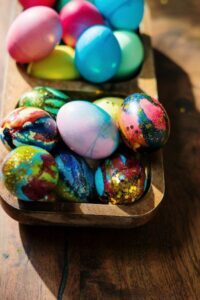 Who hasn’t sought those delicious chocolate-covered, candy-speckled, and rainbow-dyed eggs left by the E.B. in pretty baskets and springtime flowerbeds?
Who hasn’t sought those delicious chocolate-covered, candy-speckled, and rainbow-dyed eggs left by the E.B. in pretty baskets and springtime flowerbeds?
For now, however, please try not to think about chocolate as we shift to the nonedible, nondenominational types of Easter eggs—those scattered in literature and movies.
The formal name for a literary or cinematic Easter egg is an allusion. You’ve probably laughed out loud when finding one of those hidden treasures, tucked into a book or film, that was designed to call something to mind without mentioning it explicitly.
These indirect references—Easter eggs—can be an inside joke that a writer’s or movie’s fan base understands immediately, thereby creating a special bond, as if finders are suddenly part of “The In-Crowd.” Easter eggs can have a broad appeal or be subtle. They are usually somehow significant to the author or filmmaker, which is why they are included.
In addition to inside jokes, sweet Easter eggs can name an author, character, book or movie title, setting or place from another work or time, or a piece of music or work or art, thus linking one to the other; an object or symbol that foreshadows an action in the work or a character trait; a bit of dialogue; a pop culture element; an action that harks to something seemingly and momentarily unrelated; an epigraph; and, an epigram, anagram, puzzle, or set of runes that requires the brainiest of fans to decipher their surprising and often cleverly hidden messages. Sneaky, sometimes snarky, often unexpected—magical!
Sometimes, Easter eggs reveal their hiding places and messages only when we reread a work or rewatch a movie. Those can bring extraordinary ah-ha moments.
One of the most famous and prolific literary E.B.s is Stephen King. Each of his books has a single connection, one to the other. Those of us of a certain age might immediately understand the movie’s Easter egg when in The Shining, a crazed Jack Nicholson peeks through the crack in the door, as he tries to get at his terrified wife, and says, “Here’s Johnny!” Note: That phrase is not in the book, but it duplicates King’s predilection for literary Easter eggs. A “double-yolk” Easter egg, perhaps?
Such revelations of understanding can elicit comic relief, a smile, nod, wink, OMG, or outright guffaw because an E.B. has scattered the eggs successfully.
Disney’s animated movies are replete with hidden egg treasures. Eagle-eye fans have fun hunting and finding them, which are often objects or characters from previous films. In Tangled (2010), there is a wild scene at the Snuggly Duckling Pub. Perched high above the fray in the shadows is Pinocchio (1940)! And Mickeys abound. To see all forty-one Disney Easter eggs, google “Easter eggs in Disney movies,” and check out the Good Housekeeping article from 2020.
According to Samantha Knoerzer’s “The Best Easter Eggs in Literature,” in Lewis Carroll’s Through the Looking Glass, “the book has an acrostic poem that spells out ‘Alice Pleasance Liddell,’ which was the actual name of the real existing girl who inspired the fictional Alice character.” In F. Scott Fitzgerald’s The Great Gatsby, “the beginning of the book contains an epigraph . . . quoted by a man named Thomas Parke D’Invilliers. True fans should recognize the name as a fictional character in Fitzgerald’s third novel, This Side of Paradise.”
My Book 6, Upas Street: Shocking Specter, releasing in Fall 2024, will have Easter eggs of a haunted nature. Maybe that’s where I got the idea for this blog—hmmm.
But writers, be warned! Don’t be a profligate E.B. (or Wild Hare) and scatter eggs too often within a single work. By cracking too many eggs—ha, ha—you will likely lose the element of surprise and perhaps a few of your fans along the way. Wise E.B.s hide effective Easter eggs carefully so they are neither too obvious nor a stumbling block (of broken egg shells).
So, please remember: Too many Easter eggs, hidden willy-nilly, may go undiscovered. Those will turn smelly! And no one wants to read a rotten book.
(Photo Credit: Cottonbro Studio on pexels.com)
February 25, 2024
Paving the Way
Hello, Kids and All Readers,
Seven days a week, I take a three-mile walk to enhance and extend my healthspan and lifespan.
The five different routes I mapped out years ago take me over much of my historical neighborhood of North Park in San Diego, California, USA.
North Park is where I grew up and still live, so I have seen many changes, good and not as good, over the decades. While out walking these days, I enjoy the early-morning freshness, birds singing or looking for breakfast worms, charming vintage houses where I used to trick-or-treat, and the chance to say hello to my neighbors out walking their dogs.
From day to day, I never know what will inspire me as I stroll. But so far, my walks have supplied story character names, plot points, objects, and my mystery series designation, “Botanic Hill.”
Recently, I became interested in my neighborhood’s century-old sidewalk markers and started photographing them. The dates you see in the photos are from the 1900s, not the 2000s! For example, “12–15” means December 1915. I have been walking over many of these markers since I was a child, and they were already decades old by the time I was born!
Some markers have held up better than others. I like that the city saves them when the sidewalks are repaired, carefully excising, then tucking them into the new concrete, but near where they once lay. And as a bonus, some original street-name markers still appear on the corners, too.
I wonder what stories the markers could tell about the masons who made them. About the hundreds of thousands of people who have walked over those pavements. Did the masons ever imagined that their sidewalk legacies would live on over one hundred years later? Some of us see the markers as public art now. And art inspires. Recently, one marker helped me name a character–“Cawley“–in my upcoming Book 6, Upas Street: Shocking Specter.
So, get a clue, Readers. You never know where inspiration awaits! I hope you are on the lookout, wherever your paths lead you.

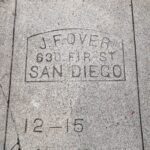
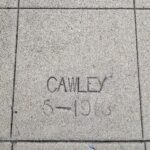
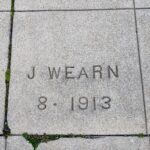
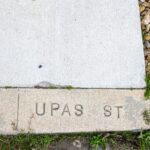
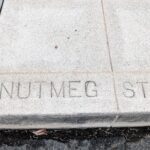
January 28, 2024
“It’s Alive!!!” . . . Well, Soon
Hello, Kids and All Readers!
Do you dare to enter Dr. Frankenstein’s La-BOR-a-tor-y?
That’s where you’ll be when you read Upas Street: Shocking Specter, Book 6 in my Botanic Hill Detectives Mysteries series, releasing in Fall 2024.
I’m finally busily working on the first draft–yay!–which is due to my editor on March 10–yikes! As Detective Lexi would say, “Wowzers!”
Our four detectives are traveling to the Welsh village of Llanfair in Southern California at the invitation of residents Mr. and Mrs. Llewellyn. The couple and other villagers have sighted a green-glowing object roaming about the countryside. It was once believed to be the ghost of stagehand Scotty Roberts. He died in a freak accident in the village’s abandoned shepherds’ watch tower in 1931 during the filming of Universal Pictures Frankenstein. The “Shocking Specter,” as it came to be known, appeared right after Roberts’ death. Then, it vanished almost as quickly as it had arrived. But not before setting fires just outside the village!
So, why in 2024, almost 100 years later, have the Shocking Specter and the fires returned? Who or what is it? Why did it disappear long ago only to reappear now? What does it want? As Detective Lanny points out, “Villains always want something!” The detectives are on the case and mean to find out.
I happily dug up–no pun intended–much fascinating information on Frankenstein, other Universal classic horror films like The Wolf Man, the studio itself, the amazingly talented actor Boris Karloff, who plays the monster with such pathos; his still-revered makeup artist, Jack Pierce, an artistic special effects pioneer, who created the monster’s iconic look; Kenneth Strickfaden, an electronics wizard and visual special effects pioneer, who invented and ran the mad scientist’s laboratory machines, thereafter known as “Dr. Frankenstein’s electrician”; and, Mary Shelley, intrepid author of Frankenstein (1818), who made all this possible. Next on my agenda: watching Poor Things with Emma Stone as a female Frankenstein’s monster.
My favorite morsels are woven into Shocking Specter to honor those artists and the Golden Age of Hollywood horror films.
So, get a clue, all Readers! I’ve even hidden a few Easter eggs in this book for your hunting pleasure. Don’t know what literary and cinematic Easter eggs are? Stay tuned for next month’s delicious blog.
Photo Credits: Frankenstein photos from commons.wikipedia.org in the public domain; Easter eggs photo by Elina Sazonova on pexels.com
